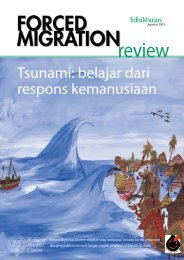FMR 42 full issue pdf - Forced Migration Review
FMR 42 full issue pdf - Forced Migration Review
FMR 42 full issue pdf - Forced Migration Review
You also want an ePaper? Increase the reach of your titles
YUMPU automatically turns print PDFs into web optimized ePapers that Google loves.
<strong>FMR</strong> <strong>42</strong><br />
Sexual orientation and gender identity and the protection of forced migrants 15<br />
under the new system applicants simply<br />
will not have time to connect with LGBT<br />
communities or organisations. Consequently<br />
it is probable that even greater weight will<br />
rest on verbal testimony. Among some<br />
decision-makers, suspicion of fraudulent<br />
claims runs high – and there is particular<br />
suspicion that people are faking sexual<br />
orientation or gender identity claims. As a<br />
result, slight inconsistencies or omissions<br />
are often interpreted as lack of credibility.<br />
Steps forward, steps back<br />
A combination of training and Federal<br />
Court decisions has improved the quality<br />
of decisions we see in Canada. Adjudication<br />
practices have become more skillful with the<br />
training of decision-makers on SOGI claims.<br />
The recently published UNHCR guidelines<br />
are an excellent step towards enhancing<br />
the quality of decision-making on SOGI<br />
refugee claims. 4<br />
In the absence of official sources, informal<br />
networks have played a critical role in<br />
facilitating access to refugee protection<br />
for LGBT forced migrants. Recently,<br />
official sources have begun to include<br />
information related to sexual orientation<br />
and gender identity claims. For example,<br />
a resource list provided by government<br />
officials at the screening interview now<br />
includes local groups for LGBT claimants.<br />
Border officers have, on some occasions,<br />
pointed out these resources to claimants<br />
as a way of signalling openness. The<br />
Refugee Board’s online guide for refugee<br />
claimants now specifically identifies<br />
sexual orientation and gender identity as<br />
examples of particular social groups.<br />
Canada’s guidelines for vulnerable persons<br />
were amended in late 2012 to recognise the<br />
potential vulnerability of LGBT claimants. 5<br />
These guidelines allow modifications to<br />
procedures for people deemed vulnerable<br />
because of age, mental illness or psychological<br />
impacts of trauma. The inclusion of LGBT<br />
claimants in these guidelines acknowledges<br />
that the psychological impacts of homophobic<br />
and transphobic trauma can interfere with<br />
people’s ability to remember and recount<br />
their experiences clearly. Demonstrating<br />
claimants’ vulnerability and determining<br />
the kinds of assistance needed are best done<br />
with input from mental health professionals<br />
and physicians. However, with recent federal<br />
cuts to health service coverage for refugees,<br />
many claimants will not have access to<br />
assessments, nor to counselling or medication<br />
that may help them stabilise enough to<br />
testify. In the extremely tight scheduling of<br />
hearings it remains to be seen how effectively<br />
procedures for vulnerability can be applied.<br />
In Canada’s major receiving cities, Montreal,<br />
Toronto and Vancouver, recognition<br />
and support for LGBT migrants among<br />
community organisations have grown<br />
over the past decade, addressing exclusion<br />
and building better support systems. Very<br />
recently, groups have formed in other cities:<br />
Halifax, Ottawa, London and Winnipeg. Yet<br />
the pace of the new system being introduced<br />
will place immense strain on the volunteers,<br />
community workers and NGO infrastructure<br />
that sustain these support systems.<br />
Sharalyn Jordan sjordan@sfu.ca is Assistant<br />
Professor, Counselling Psychology, at Simon<br />
Fraser University, Canada. Chris Morrissey<br />
info@rainbowrefugee.ca is the Founder of<br />
Rainbow Refugee in Vancouver, BC, Canada<br />
www.rainbowrefugee.ca Both are communitybased<br />
advocates and researchers with lesbian,<br />
gay, bisexual and transgender queer (LGBTQ)<br />
refugees in Canada.<br />
1. Rape of a person because of their perceived sexual or gender<br />
orientation; the intended consequence of the rape, as seen by<br />
the perpetrator, is to ‘correct’ their orientation – to turn them<br />
heterosexual or to make them act more in conformity with gender<br />
stereotypes.<br />
2. Jordan, S R (2010) ‘Un/Convention(al) Refugees: Contextualizing<br />
the accounts of refugees facing homophobic or transphobic<br />
persecution’, Refuge 26, 2, 165-182.<br />
http://pi.library.yorku.ca/ojs/index.php/refuge/article/view/32086<br />
3. Negative impact on well-being caused when a person feels<br />
there is a mismatch between their biological sex and their gender<br />
identity.<br />
4. UNHCR (2012) Guidelines on International Protection No. 9:<br />
Claims to Refugee Status based on Sexual Orientation and/or<br />
Gender Identity within the context of Article 1A(2) of the 1951<br />
Convention and/or its 1967 Protocol relating to the Status of<br />
Refugees HCR/GIP/12/01 See box on p7.<br />
5. http://tinyurl.com/IRB-Guideline8




